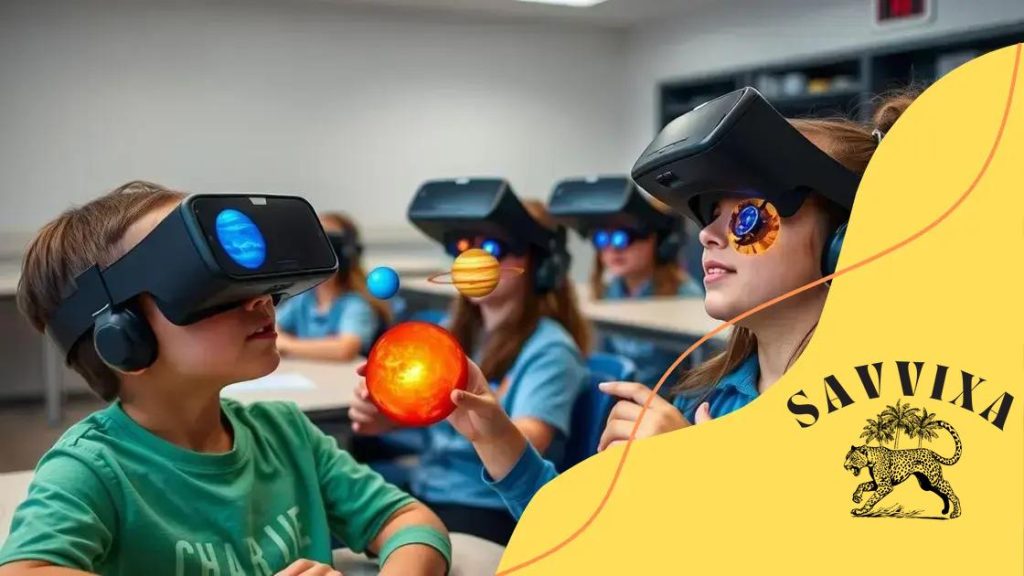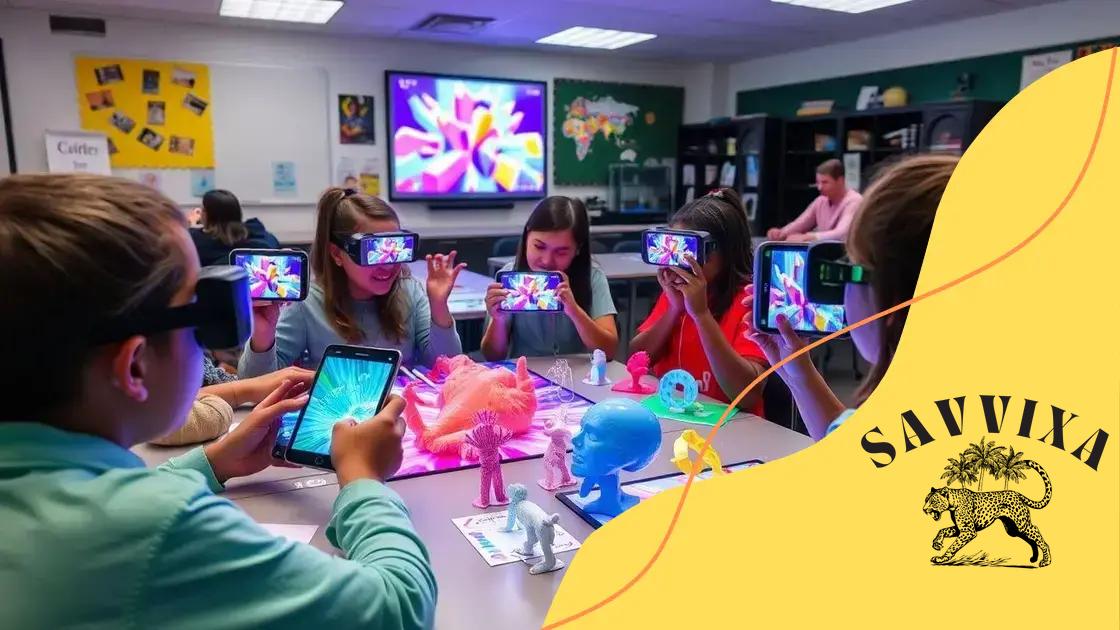How AR is being used for hands-on learning experiences

Augmented reality (AR) in education enhances learning by providing interactive experiences that engage students, facilitating creative expression, real-world applications, and personalized learning paths.
How AR is being used for hands-on learning experiences is changing the landscape of education. Imagine stepping into a virtual lab where you can conduct experiments without limitations. Intrigued? Let’s explore how this technology is redefining learning.
Understanding augmented reality in education
Understanding augmented reality in education is crucial for modern learning experiences. This technology enables students to interact with digital content in a way that feels real and engaging. By overlaying virtual elements onto the real world, AR helps to bridge the gap between theory and practice.
What is Augmented Reality?
Augmented reality is a technology that integrates digital information with the user’s environment in real time. It can enhance learning by providing immersive experiences that traditional methods cannot offer.
- AR can display 3D models of complex subjects.
- It makes abstract concepts more tangible.
- Students can visualize historical events or scientific processes dynamically.
This versatility allows educators to cater to different learning styles. Visual learners, for instance, benefit immensely when they can see and interact with 3D models.
Benefits of AR in Education
There are numerous benefits of implementing AR in the classroom. First, it boosts engagement; students are often more interested in lessons that incorporate technology. Additionally, AR can enhance retention by creating memorable and interactive experiences.
Moreover, augmented reality promotes collaboration, as students can work together in a shared digital space. This interaction fosters communication and teamwork skills, essential for future success.
When students encounter challenging subjects, AR provides a much-needed boost of motivation. Seeing concepts come to life helps demystify learning. In subjects such as biology or physics, AR can illustrate processes that may otherwise be difficult to comprehend.
Lastly, as educators explore augmented reality tools, they find it incredibly versatile for various subjects—from mathematics to the arts. The adaptability of AR makes it a valuable asset in educational curriculums.
The role of AR in science learning
The role of AR in science learning is transformative. By allowing students to visualize complex concepts, augmented reality makes science more approachable and exciting.
Bringing Science to Life
With augmented reality, students can engage with realistic simulations of scientific phenomena. For example, they can observe chemical reactions or explore the anatomy of a human body in 3D. This interactive learning enhances understanding and retention.
- Students can manipulate molecules and see their interactions.
- Viewing geographical features in 3D helps in understanding earth sciences.
- Simulating physics experiments safely in a virtual environment.
Moreover, AR encourages inquiry-based learning. Instead of passively receiving information, students can explore and ask questions about what they see. This fosters a deeper connection with the scientific material.
Game-Based Learning
Another exciting aspect of augmented reality is its ability to create game-like experiences. Educational games built with AR can make learning enjoyable while teaching core scientific principles. These games often incorporate challenges that require critical thinking and problem-solving skills.
For instance, students might need to complete experiments or identify biological species in a virtual scavenger hunt. This incorporation of fun into science learning can motivate students who might otherwise be disengaged.
As technology continues to advance, the applications of AR in science classes will expand further. Educators can create tailored experiences that meet the diverse needs of their students. By harnessing the power of augmented reality, science learning becomes not just informative but also a thrilling adventure.
Enhancing creativity with AR tools

Enhancing creativity with AR tools is revolutionizing how students express themselves. Augmented reality allows for innovative ways to create and share ideas. It offers unique opportunities for artistic exploration that traditional methods cannot match.
Interactive Art Creation
With augmented reality, students can create art in a digital space. They can design 3D models, experiment with colors, and manipulate virtual objects. This interactivity encourages engagement and imagination.
- AR tools facilitate collaborative art projects.
- Students can showcase their work in immersive environments.
- They can receive immediate feedback through interactive features.
Using AR, students can bring their creations to life, enabling them to visualize their ideas in ways that enhance their artistic skills. Imagine crafting a painting that has animated elements or a sculpture that interacts with viewers!
Storytelling and AR
Another exciting application of augmented reality is in storytelling. AR can transform narratives by adding layers of information and visuals. Students can create stories that come alive as readers engage with the text through interactive elements.
This approach not only develops writing skills but also fosters critical thinking and creativity. By utilizing AR, students can explore character development, plot structure, and themes in a more dynamic fashion.
As they develop their stories, they can create illustrations that readers can interact with. This immersive experience captivates audiences and encourages students to explore new ideas and perspectives. The combination of technology and creativity offers endless possibilities for personal expression.
Real-world applications of AR in classrooms
Real-world applications of AR in classrooms are changing how teachers engage students. Augmented reality provides practical, interactive experiences that enhance learning. By bringing academic content to life, students connect theories to real-world scenarios.
Interactive Learning Experiences
One major application of augmented reality is in creating interactive learning environments. For example, science students can use AR apps to explore biological processes by manipulating virtual organisms. This hands-on approach fosters engagement and retention.
- Students can virtually visit historical sites to enhance their understanding of history.
- Math concepts can be visualized through 3D representations, making them easier to grasp.
- Language learners can practice vocabulary with interactive games.
These interactive features not only capture students’ attention but also provide practical experiences that deepen their understanding.
Field Trips and Virtual Exploration
Another exciting use of AR is for virtual field trips. Rather than traveling to distant locations, students can embark on virtual adventures right from their classroom. This accessibility opens doors for all learners.
Imagine students exploring the depths of the ocean or walking through ancient civilizations without leaving their desks. This innovative approach brings new perspectives to subjects like geography and environmental science. Additionally, AR facilitates collaboration as students can share experiences and work on projects together.
As educators continue to implement augmented reality tools, they discover new ways to enhance instructional methods. Teachers can tailor lessons to their students’ needs, resulting in a more personalized learning experience that prepares students for the future.
Challenges and future of AR in education
Challenges and the future of AR in education present an intriguing landscape. While the potential of augmented reality is vast, there are obstacles to overcome for successful implementation.
Technical Limitations
One primary challenge is the technical limitations of AR technology. Schools often face issues with access to the required hardware and software. Without adequate devices or a stable internet connection, the experience can be frustrating for students.
- High-quality AR applications require advanced devices.
- Inconsistent internet connectivity can hinder seamless interactions.
- Maintenance and updates for AR tools can be resource-intensive.
These technical obstacles can deter teachers from fully integrating AR into their lessons, limiting the benefits students can gain.
Training and Support
Another significant challenge is the need for training and support. Educators must feel comfortable using augmented reality tools to effectively teach their students. Without proper training, they may struggle to incorporate AR into their curriculum.
Workshops and professional development can help teachers understand how to use these tools. Additionally, ongoing support is vital as technology evolves. By providing the necessary resources, schools can foster a culture of innovation and adaptability.
Looking to the future, the adoption of AR in education will likely grow as technology advances. As devices become more affordable and accessible, more classrooms may embrace AR as a teaching aid.
Moreover, as developers create more engaging and user-friendly applications, the content delivered through AR will continue to improve. This evolution can lead to exciting experiences for students, making learning more interactive and enjoyable.
In conclusion, augmented reality is transforming education by providing interactive learning experiences that engage and inspire students. Although there are challenges such as technical limitations and the need for teacher training, the future of AR in the classroom looks bright. As technology evolves, more students will have access to rich, immersive learning environments. Embracing AR tools can lead to enhanced creativity, better understanding of complex concepts, and a more engaging educational experience overall.
FAQ – Frequently Asked Questions about Augmented Reality in Education
How does augmented reality enhance learning experiences?
Augmented reality creates interactive and immersive learning environments, allowing students to visualize complex concepts and engage more actively in their education.
What are some challenges of implementing AR in classrooms?
Challenges include technical limitations, access to devices, and the need for teacher training to effectively integrate AR tools into the curriculum.
Can AR tools be used across different subjects?
Yes, augmented reality can enhance learning in various subjects, such as science, history, and art, by providing relevant and engaging experiences related to the content.
What is the future of AR in education?
The future looks promising as AR technology continues to advance, becoming more accessible and user-friendly, which will likely result in wider adoption in classrooms.